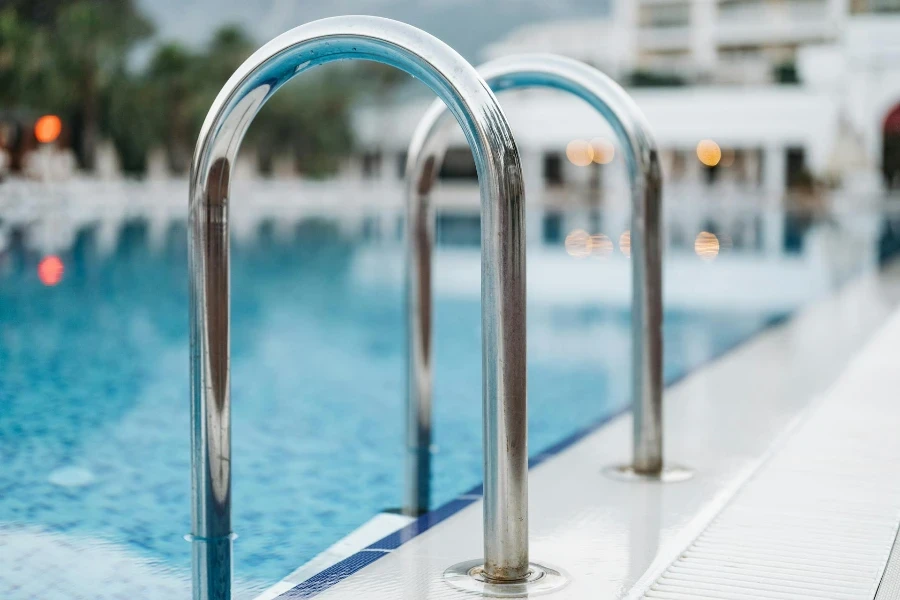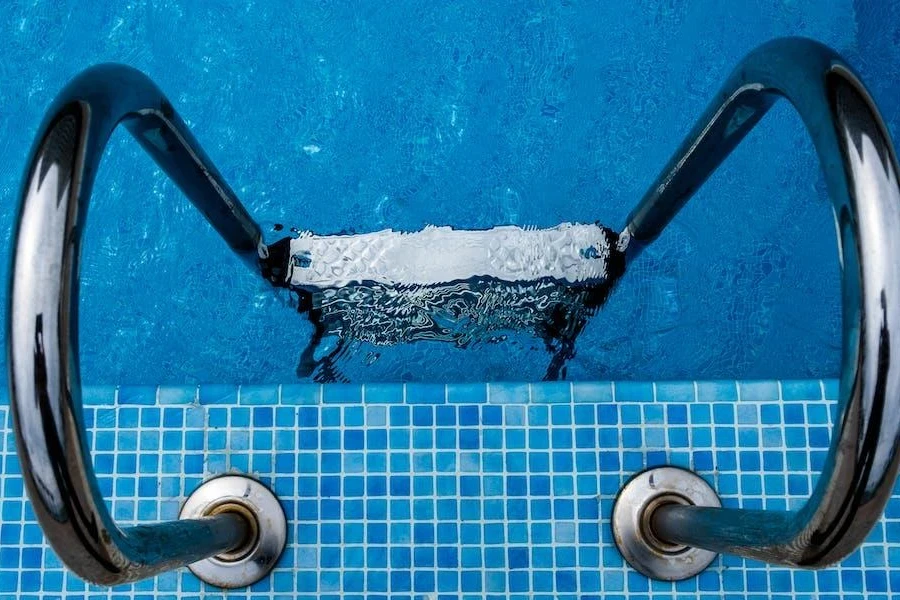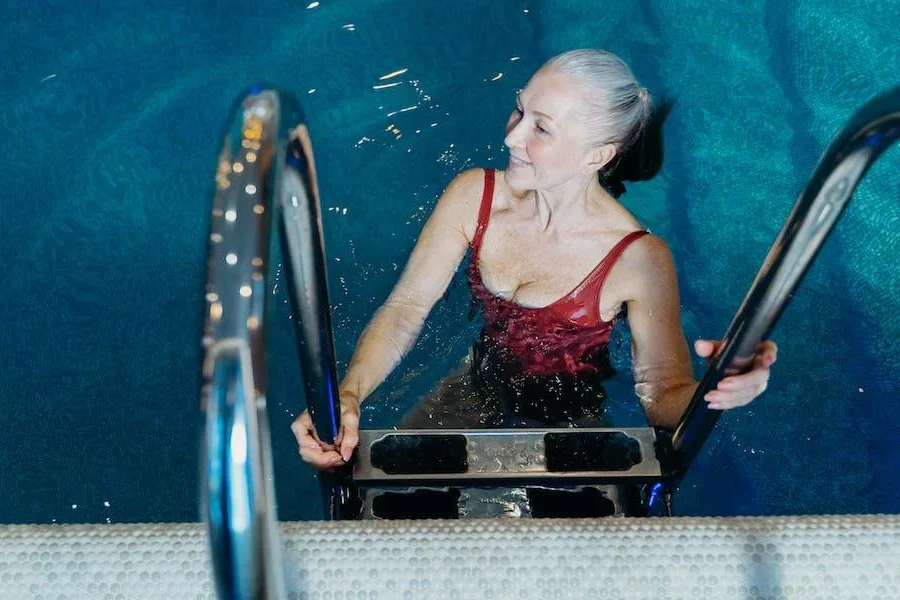Swimming pools are simply amazing. They’re a great way to feel refreshed while getting a good workout. So, it’s no surprise that 8% of the total number of households in the U.S. alone have swimming pools—and that’s without counting commercial pools.
Nevertheless, pools can get dangerous if consumers lack safety equipment. Pool ladders and stairs are one of the necessities, allowing people to go in and out of pools safely. This article will give businesses insight into the key factors they need to consider to ensure they select the best pool ladders and stairs on the market in 2024.
Table of Contents
What’s the size of the pool ladder market?
5 things to consider when selecting pool ladders
Wrapping up
What’s the size of the pool ladder market?
Consumers can’t build new pools or renovate old ones without considering pool ladders. And this is why pool ladders are an essential part of the global swimming pool construction market, which experts expect to reach a value of USD 10 billion by 2030, growing from USD 7 billion in 2021 at a 4.1% compound annual growth rate (CAGR). Analysts also divide the market into in-ground and above-ground pools. In-ground pools registered the highest market share with a 4.6% CAGR forecast, indicating ladders are also in high demand.
North America is also the largest regional sector with the highest contribution. Experts anticipate the region will grow at a 4.1% CAGR over the forecast period.
5 things to consider when selecting pool ladders
Ladder vs. stairs vs. ledges

Ladders, stairs, and ledges may all do the same thing, but each offers a different way for consumers to go in and out of their favorite pools. And each one offers something different for the two pool types.
Pool ladders
Pool ladders offer two variants: one for private pools and another for public ones. Public pool ladders feature Olympic-type ladders that boast incredible stress resistance. These are the best options for public pools because such ladders won’t give in to wear and tear from the sheer number of people accessing them.
Olympic-type ladders are also the go-to for public tools because manufacturers make them with specific characteristics to meet safety standards. However, private pools don’t need any of these requirements. For that reason, private pool owners are free to run wild with their ladder customizations. So, sellers can use various shapes and styles, especially regarding the handrails.
Note: Both ladder types apply to in-ground and above-ground pools.
Pool steps
Unlike ladders, pool steps offer some variety for both pool types. Public and private in-ground pools often have built-in steps (usually three) at the shallow end. These steps come from concrete and often match the pool’s aesthetic.
In contrast, above-ground pools have installable steps since they don’t even have as much construction as in-ground variants. Although some inground pools use these steps, they’re not as common for them as their concrete counterparts.
Installable steps may also appeal to consumers (especially private pool owners) who don’t want to modify their pool’s structure. Regardless of type, pool steps come with non-slip edges to remain safe underwater. Like pool ladders, steps can also come in various shapes and styles to compliment the pool’s overall aesthetics.
Pool ledges
Pool ledges are gaining momentum for their increased versatility. They can do more than let consumers go in and out of pools. Pool lovers can also use ledges for lounging, tanning, cooling off, playing, or relaxing.
Usually, pool ledges stay at the deeper ends of pools. But owners can place them anywhere they want. These ledges also have a 500mm consistent depth and can be 400 to 600mm wide. Pool ledges are perfect for toddlers and young children to have fun. But only when they have necessary safety measures to stop them from falling into the deep end.
Pool type

As mentioned earlier, pool ladders offer something different for in-ground and above-ground pools. Here’s a closer look at the two types and what ladders they require.
In-ground pools
Consumers will most likely choose pool ladders or stairs that match their pool’s shape and style. Since their pools will also have decks, they want to create a seamless transition from them to the steps.
Some pool owners will go for detachable ladders if they don’t want to make provisions for in-built stairs or don’t trust the safety of immersing footholds in water. Others will go for in-built stairs if they don’t wish to detract from their pool’s look.
Above-ground pools
Consumers with these pools have more choices when it comes to pool ladders, but mostly depending on whether they have a deck or not. Suppose their above-ground pools have decks. They’ll need ladders that go into the water, like in-ground pools.
However, above-ground pools without decks will need A-frame ladders. These types have two bottoms, one going into the pool (for coming out) and the other staying outside (for going in). The same concept applies to installable steps for above-ground pools. These pools are usually private, so consumers can choose more sophisticated and visually appealing styles.
Railing type
Now, just because consumers have built-stairs doesn’t mean businesses can’t make a sale. That’s where railings come in. Built-in stairs are often non-slip concrete slabs without anything for swimmers to hold on to when entering or leaving in-ground pools. So, owners are advised to purchase and install railings to increase their pool’s safety.
Ladders also have this requirement. Since it’s water, consumers need something to hold while lifting themselves out of the pool. Hence. Businesses must always prioritize ladders with railings, whether the target is in-ground or above-ground pools.
More importantly, the railings will support a lot of weight, so they must be stable and sturdy. Businesses can also include masonry screws in the package, providing a trusted way for consumers to install these railings.
Materials

If businesses want to focus on ladders, they must choose the material they’ll want for their products. Usually, manufacturers make pool ladders from alloy stainless steel or plastic resin. Both materials offer impressive corrosion resistance and durability, making them the best options for pool life.
However, both ladder materials are fundamentally different. Resin ladders are often more affordable, lightweight, and low maintenance. While stainless steel ladders also don’t need much maintenance, they’re more expensive, heavier, and common for inground pools.
Plus, stainless steel ladders are also more stable than their resin counterparts. Interestingly, some ladders blend stainless steel with resin components to offer the best of both worlds. For example, they may have non-slip resin steps and stainless steel railings.
Note: the same applies to detachable pool stairs.
Size

Size is a more important requirement for above-ground pools. For these pools, the preferred ladder must be tall enough to reach the pool’s bottom while reaching the deck or extending to the other side (outside).
Thankfully, most above-ground ladders and steps have adjustable features, usually by a few inches. On the other hand, inground pool ladders must not reach the bottom. Instead, some pools add a few steps to the bottom, making it easier to climb in or out.
Another aspect to consider is step width. Some steps are as wide as 24” while others only offer 18” of step space. Generally, wider steps are easier to climb than narrower counterparts.
Weight capacity also works hand-in-hand with size. Will the ladder handle all weights? Or will it have a capacity limit? Whatever the choice, sellers must ensure their offerings are sturdy enough to handle their target’s needs.
Wrapping up
Pool ladders are necessary for every pool. Consumers often need them during construction, setting up , and renovation stages. Without them, accessing pools would be a dangerous activity.
Since these accessories are critical for safety, businesses must carefully consider their options before investing. They must check the pool type, railing, size (and weight capacity), and materials to ensure they offer nothing but the best quality in 2024.



